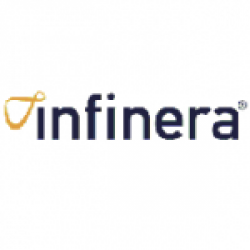Terabit PICs and FlexChannels to Improve Capacity, Economics
Sunnyvale, CA on 8 April 2011
Infinera (Nasdaq: INFN) today announces a vision to continue leading the industry in implementing the Terabit Age, and expand its Digital Optical Networks solutions with a range of new technologies that will enable service providers and network operators to scale their networks to multi-Terabits of capacity. Next Tuesday, April 12th, Infinera Director of Solutions and Technology Geoff Bennett will spell out the company’s vision of how networks evolve to the Terabit Age in a presentation at the Layer123 Terabit Optical Networking Conference in Cannes, France.
Network traffic continues to grow at double-digit and triple-digit rates, driven by a wide range of bandwidth-hungry applications including new business applications for the network, and growing personal use of video, broadband mobile access, and other innovative internet applications. Businesses are deploying cloud computing solutions, relying on networks and ever-larger data centers to deliver economies in their IT budgets. Growing bandwidth availability for mobile networks has created a mobile revolution, with more than 1.6 billion mobile phones in use in China and India, equivalent to more than one phone for every two people. According to research firm Telegeography, in 2010 international Internet traffic grew by 62%[1] with some regions including Eastern Europe and India/South Asia growing at more than 100%. This exponential growth places new demands on optical networks, requiring them to scale network capacity quickly and seamlessly to accommodate growing data traffic.
As the leader in Digital Optical Networks, Infinera is developing the technology to meet these challenges. As a first step, Infinera plans to further scale its industry-leading photonic integrated circuits to support 1 Terabit/second (1Tb/s) capacity per chip. These Terabit PICs will enable the future productization of systems with integrated bandwidth management and WDM transport delivering multi-Terabits of capacity, maximizing system density, lowering space use, and significantly simplifying increases in network capacity.
The 1Tb/s photonic integrated circuits will enable service providers to deploy bandwidth using a new form of flexible WDM channel termed FlexChannels. Infinera Digital Optical Networks will in the future support FlexChannels with 1Tb/s of capacity, increasing by tenfold the “capacity per channel” over 100Gb/s systems that are being introduced into the market today. Infinera’s Terabit FlexChannels will be designed to utilize advanced multi-carrier, coherent phase modulation to maximize optical reach and total fiber capacity. By leveraging Infinera’s FlexCoherent technology, which allows software-controlled modulation, Terabit FlexChannels will be configurable to support different modulation types, different number of carriers, and flexible WDM spectrum use, enabling WDM capacity to scale up to 25Tb/s per fiber. Even greater capacities will be possible in the future through the extension of WDM system operation across more of the fiber spectrum. Infinera’s 1Tb/s FlexChannels will be integrated as part of Infinera’s next generation multi-Terabit networking solutions.
“Pioneered by Infinera, large-scale photonic integration has already demonstrated the ability to scale network capacity with great benefits in functionality, cost, size, and power consumption. The extension of photonic integration into the terabit realm will help carriers meet the bandwidth challenges of the next decade,” said Heavy Reading analyst Sterling Perrin.
Based on the Digital Optical Networks architecture, Infinera optical systems deliver a set of digital features and functionality, including Digital ROADM capabilities, Bandwidth Virtualization to support the deployment of bandwidth to deliver any service between any two points on the network, and end-to-end Digital OTN services. The Digital Optical Networks paradigm enables customers to build fast, flexible and scalable networks for the 21st century, and achieve superior economics in their networks.
[1] Source: http://www.telegeography.com/cu/article.php?article_id=34653
About Infinera
Infinera provides Digital Optical Networking systems to telecommunications carriers worldwide. Infinera’s systems are unique in their use of a breakthrough semiconductor technology: the photonic integrated circuit (PIC). Infinera’s systems and PIC technology are designed to provide customers with simpler and more flexible engineering and operations, faster time-to-service, and the ability to rapidly deliver differentiated services without reengineering their optical infrastructure. For more information, please visit http://www.infinera.com/.
This press release contains certain forward-looking statements based on current expectations, forecasts and assumptions that involve risks and uncertainties. These statements are based on information available to Infinera as of the date hereof; and actual results could differ materially from those stated or implied, due to risks and uncertainties. Forward-looking statements include statements regarding Infinera’s expectations, beliefs, intentions or strategies regarding the future including that Infinera continues to lead the industry in implementing the Terabit Age, that its Digital Optical Networks solutions have a range of new technologies that will enable service providers and network operators to scale their networks to multi-Terabits of capacity, that the 1Tb/s photonic integrated circuits will enable service providers to deploy bandwidth using a new form of flexible WDM channel termed FlexChannels; that Infinera Digital Optical Networks will in the future support FlexChannels with 1Tb/s of capacity, increasing by tenfold the “capacity per channel” over 100Gb/s systems that are being introduced into the market today; that Infinera Digital Optical Networks will in the future support FlexChannels with 1Tb/s of capacity, increasing by tenfold the “capacity per channel” over 100Gb/s systems that are being introduced into the market today; that Infinera’s Terabit FlexChannels will be designed utilize advanced multi-carrier, coherent phase modulation to maximize optical reach and total fiber capacity; that by leveraging Infinera’s FlexCoherent technology, which allows software-controlled modulation, Terabit FlexChannels will be configurable to support different modulation types, different number of carriers, and flexible WDM spectrum use, enabling WDM capacity to scale up to 25Tb/s on a pair of fibers; that even greater capacities will be possible in the future through the extension of WDM system operation across more of the fiber spectrum that Infinera’s 1Tb/s FlexChannels will be integrated as part of Infinera’s next generation multi-Terabit networking solutions; and that The Digital Optical Networks paradigm enables customers to build fast, flexible and scalable networks for the 21st century, and achieve superior economics in their networks. Such forward-looking statements can be identified by forward-looking words such as “anticipated,” “believed,” “could,” “estimate,” “expect,” “intend,” “may,” “should,” “will,” and “would” or similar words. The risks and uncertainties that could cause our results to differ materially from those expressed or implied by such forward-looking statements include aggressive business tactics by our competitors, our dependence on a single product, our ability to protect our intellectual property, claims by others that we infringe their intellectual property, and our ability to respond to rapid technological changes, and other risks that may impact any of the group’s business are set forth in their annual reports on Form 10-K filed with the SEC on March 1, 2011, as well as subsequent reports filed with or furnished to the Securities and Exchange Commission. These statements are based on information available to us as of the date hereof and we disclaim any obligation to update the forward-looking statements included in this press release, whether as a result of new information, future events or otherwise.




